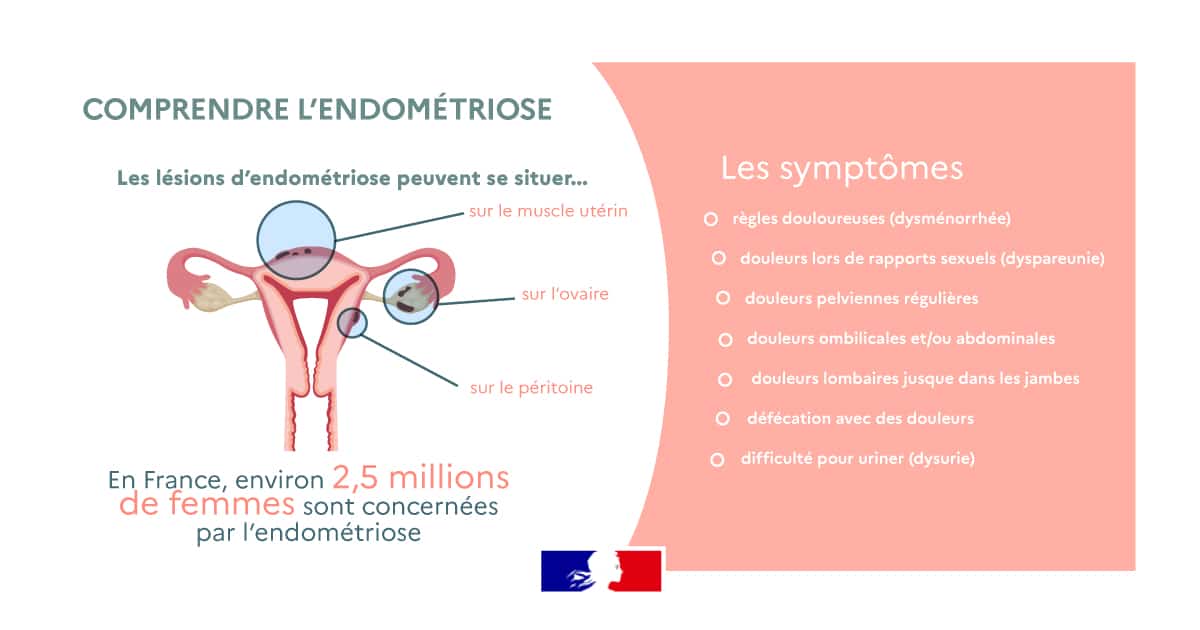Fertility
Endométriose: An infernal cycle
Although still misunderstood, the endométriose begins to be talked about and many awareness-raising actions are emerging. But who is it really and how can we fight it effectively?
What is endométriose ?
In a healthy woman, with each menstrual cycle, under the effect of estrogenic hormones, the lining of the uterus, also called endometrium, thickens in anticipation of a possible pregnancy. If there is no fertilization, it disintegrates and bleeds: these are the rules.
The endométriose is a chronic disease related to hormonal change in estrogen levels that affects the endometrium. It affects nearly 10% of women of childbearing age worldwide. Hormonal variations in the menstrual cycle cause cells from the inner lining of the uterus to migrate out of it. However, when the bleeding fails to be evacuated by the body, this displacement causes the cells of the endometrium to graft themselves to other genital organs, such as the ovaries or the vagina, but also to the level of the digestive and urinary organs. . However, the cause of this abnormal migration remains unknown.
In addition to lesions, cysts as well as inflammations, this event causes adhering of neighboring organs to each other and prevents their good mobility.
The main symptom of endométriose is pain in the pelvis. Stronger during menstruation, it manifests itself in continuous pain during sexual intercourse, defecation or urination. The pain is often more severe over time.
The endométriose is also a cause of infertility, especially when the endometrial tissue causes dysfunction or even blockage of the ovaries.
Finally, some forms of endométriose are asymptomatic. These are only discovered during an infertility check-up.
How to treat endométriose ?
Currently, support for endométriose is based on three techniques, used according to the symptoms but also if there is a desire for pregnancy of each patient.
First of all the hormonal treatments, which are mainly aimed at reduce the impact of menstrual cycles on the symptoms of the disease. Several types of contraceptives can be prescribed: estrogen-progestogens, oral microprogestogens, etc. Other medications are also used as supplements, such as analgesics to limit pain.
In case of excessive pain and ineffectiveness of hormonal treatments, the surgery may be considered. It varies according to the region in which the lesions are located. It consists of removing the areas in which the endometrial cells have lodged.
Finally, in the event of a desire for pregnancy, a medically assisted procreation can be offered. This management involves in particular ovarian stimulation (during an endométriose mild to moderate) or through in vitro fertilization (during endométriose more important).
How is the research progressing?
Endo researchmétriose is very active. The studies focus in particular on the causes of the disease, its evolution and the factors that influence it.
Personalized recherches focus on the genetic risks of developing endométriose. Discovering and identifying a combination of several genetic and epigenetic factors could make it possible to diagnose the disease early and therefore accelerate its treatment. Identifying genes involved in the disease can also lead to the identification of potential therapeutic targets.
Advances are also expected from the point of view of carrying out the diagnosis of the disease, in particular from the point of view of imaging in order to avoid overly invasive biopsies.
On the side of the causes, the researchers believe that a immune dysfunction plays a role in the disease: it would explain the non-elimination of endometrial cells outside the uterus and the chronic inflammation. Exploring these causes could provide promising avenues for developing innovative treatments.
Finally, the endométriose could also have impact on pregnancyincreased risk of miscarriages, fetal growth retardation, etc.: research is therefore looking into these possible harmful effects with a view to improving patient care.
Nurilia's solution
Since its creation, the Nurilia laboratory has been working on the design of products that promote the well-being and fertility of couples. The obstacle represented by the endométriose to get pregnant is a major adversary that we try to fight every day. It is for this reason that we have developed Métriose.
Thanks to its high quality scientific and natural composition, this dietary supplement is our solution to counteract the harmful effects of the disease. By acting, first of all, on oxidative stress, it aims to regulate the various fertility disorders.
Finally, it reduces the pain due to the characteristic inflammation of the endométriose by providing natural plant extracts.
The fight of women against endométriose is an ongoing struggle that turns out to be painful. At Nurilia, your child's health comes first through yours. It is with this in mind that we work every day for your comfort and to offer you the chance to start a family.
come visit our online store to discover our different solutions.
Join us on social networks, so you don't miss any news!
We are present on Facebook, Instagram et LinkedIn !

